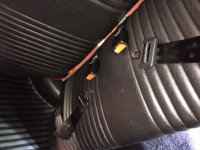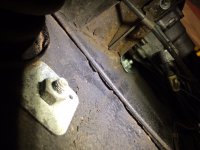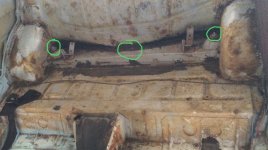You are using an out of date browser. It may not display this or other websites correctly.
You should upgrade or use an alternative browser.
You should upgrade or use an alternative browser.
General pics of Rear seat seatbelt mounts?
- Thread starter jtrashy
- Start date
Currently reading:
General pics of Rear seat seatbelt mounts?
the hobbler
Distinguished member
- Joined
- Jul 25, 2012
- Messages
- 4,084
- Points
- 1,013
Is it seat belts for the rear seat that you are trying to fit? Or, is it the rear mounts for the front seat belts? Both of these subjects have been covered before on the forum (apologies that I am not clever enough on a computer to bring them up). If you go onto 'google' and type in "fitment of seat belts to a classic Fiat 500" OR " fitment of rear seat belts to a classic 500" (whichever is appropriate) a number of sites will appear, some of which have pictures , which should help you. The problem is that the 500 was never supplied, from the factory, with seat belts fitted. However, the 500L had the fitment points in place. If you are fitting inertia-reel FRONT seat belts, the reels can be bolted to the rear of the footwell (beneath the rear seat) with a bolt through the vertical panel. A large washer/load-plate must be fitted under the head of the bolt.
AndrewHarvey
Established member
- Joined
- Jan 17, 2015
- Messages
- 1,471
- Points
- 290
I've fitted rear "reel inertia" belts.
I used information shared with Franko @ RicambioUK
I will try to upload images.
Seatbelt brackets are available with captive nuts
I used information shared with Franko @ RicambioUK
I will try to upload images.
Seatbelt brackets are available with captive nuts
I also had lap belts in the back although I question my own mounting process - the clip end of each was mounted to the bolts next to wheel arch and the buckles of both on a bolt with large washer/brackets like Hugh’s through a hole drilled into that central area.
I know it’s probably not up to Australian safety standards but neither is the rest of the car and I think if an accident of a magnitude that pushed this method of seatbelt mounting beyond its limits were to happen, the seat belts would not be saving anyone anyway.
I know it’s probably not up to Australian safety standards but neither is the rest of the car and I think if an accident of a magnitude that pushed this method of seatbelt mounting beyond its limits were to happen, the seat belts would not be saving anyone anyway.
Attachments
I note that the OP is based in the U.S. There's several specialists in the U.S. that supply seat belts for classic cars who might be able to help.
In the U.K. :-
www.quickfitsbs.com/gallery_fiat.php shows an installation on a Fiat 500, although it seems to be on the Giardiniera model? Might give some ideas.
Britax? seat belt manufacturers in the U.K. used to supply fitting kits for cars which didn't have factory mounts incl. plates with captive nuts, shouldered bolts/washers, stepped spacers, threaded tubes to insert either through 'B' pillars from the outside or fished up/down to the correct height. Some of the plates could be fished through box sections e.g. sills/rocker panels to the correct location and then fixed in position using pop rivets or small self-tapping screws, indeed some of these plates came with pre-drilled small holes in opposite corners for this purpose. Some of the mounting plates were smaller in size maybe 40x20x10?mm thick and threaded through - no extra nut required.
In the interest of safety, I'd suggest trying to get a look at the factory fitted mountings on the 500L or the Fiat 126 (which definitely had mountings but are sometimes obscured by rubber plugs/sound deadener material under the rear seat!) and try to duplicate these types/locations. These mounting usually took the form of a steel plate approx 50 x 30 x 2.5mm with the long sides bent up into a flange and a nut spot-welded in place. Seat belts bolts regardless of use in the U.K. or continental Europe were always threaded 7/16 inch UNF (iirc 20t.p.i.). This size bolt takes an 11/16"AF socket but many people just use a 17mm one.
You could always cut suitable seat belt mounting plates from a scrap car (even a modern one :devil: ) and use these.
AL.
In the U.K. :-
www.quickfitsbs.com/gallery_fiat.php shows an installation on a Fiat 500, although it seems to be on the Giardiniera model? Might give some ideas.
Britax? seat belt manufacturers in the U.K. used to supply fitting kits for cars which didn't have factory mounts incl. plates with captive nuts, shouldered bolts/washers, stepped spacers, threaded tubes to insert either through 'B' pillars from the outside or fished up/down to the correct height. Some of the plates could be fished through box sections e.g. sills/rocker panels to the correct location and then fixed in position using pop rivets or small self-tapping screws, indeed some of these plates came with pre-drilled small holes in opposite corners for this purpose. Some of the mounting plates were smaller in size maybe 40x20x10?mm thick and threaded through - no extra nut required.
In the interest of safety, I'd suggest trying to get a look at the factory fitted mountings on the 500L or the Fiat 126 (which definitely had mountings but are sometimes obscured by rubber plugs/sound deadener material under the rear seat!) and try to duplicate these types/locations. These mounting usually took the form of a steel plate approx 50 x 30 x 2.5mm with the long sides bent up into a flange and a nut spot-welded in place. Seat belts bolts regardless of use in the U.K. or continental Europe were always threaded 7/16 inch UNF (iirc 20t.p.i.). This size bolt takes an 11/16"AF socket but many people just use a 17mm one.
You could always cut suitable seat belt mounting plates from a scrap car (even a modern one :devil: ) and use these.
AL.
Last edited:
I think I am correct in saying that the square flanges on the underside
should be welded in position.
I tried fitting inertia reel front belts but they seemed to intrude to far into the rear passenger footwell creating problems getting in or out.
should be welded in position.
I tried fitting inertia reel front belts but they seemed to intrude to far into the rear passenger footwell creating problems getting in or out.
Some more info:-
www.securon.co.uk Manufacturers of Seat Belt systems.
www.securon.co.uk/fitting/extras/254fitting.htm
www.securon.co.uk/fitting/seat_belts_fitting.htm
www.securon.co.uk/fitting/extras/seat_belts_helpful.htm
www.securon.co.uk/fitting/extras/brackets.jpg (see brackets at bottom)
This Co. doesn't recommend any fitting service, it advises consulting a garage or mechanic. It lists all types of parts incl brackets individually. It also mentions that 7/16"UNF is the thread size 'usually' used and the correct bolt torque is 25 - 35 Nm.
Another source of brackets/re-inforcing backing plates might be a classic vehicle specialist who has fitted seat belt kits to classic cars which didn't have factory mountings originally. when doing this kind of work, it's not unusual to accumulate spare brackets etc.
AL.
www.securon.co.uk Manufacturers of Seat Belt systems.
www.securon.co.uk/fitting/extras/254fitting.htm
www.securon.co.uk/fitting/seat_belts_fitting.htm
www.securon.co.uk/fitting/extras/seat_belts_helpful.htm
www.securon.co.uk/fitting/extras/brackets.jpg (see brackets at bottom)
This Co. doesn't recommend any fitting service, it advises consulting a garage or mechanic. It lists all types of parts incl brackets individually. It also mentions that 7/16"UNF is the thread size 'usually' used and the correct bolt torque is 25 - 35 Nm.
Another source of brackets/re-inforcing backing plates might be a classic vehicle specialist who has fitted seat belt kits to classic cars which didn't have factory mountings originally. when doing this kind of work, it's not unusual to accumulate spare brackets etc.
AL.
I think I am correct in saying that the square flanges on the underside
should be welded in position.
I tried fitting inertia reel front belts but they seemed to intrude to far into the rear passenger footwell creating problems getting in or out.
I think the factory installed plates are spot-welded in position but this may simply to keep them in position if e.g. the seat belt bolt is removed?
When I fitted seat belts to cars without factory mounting points, (back in the good ol' days
I never saw any mention of it being necessary to weld the plates in position. But I would agree, it's probably better to weld the backing/load-spreading plates in position, even a tack weld at each corner would make for a more secure installation. Problem is not everyone has access to welding equipment, most probably just want to drill a few holes and bolt the seat belts in position.
Re:- the inertia reel units intruding into the rear passenger footwell?
I've seen some cars which house the inertia reel units behind the trim panels that are behind the 'B' pillars and at each side of the rear seat. I suspect there would be insufficient room to do this on the 500 and it would likely require welding in addition metal to provide mounting locations. Such installations typically used a shaped trim panel to allow the belt to move in/out easily and a cover over the belt slot to prevent chafing of the belt material.
Not long ago, someone on here posted pics of his installation of inertia reel seat belts on his 500, might have been Hugh Jarce or the hobbler?
And I'm sure I don't need to mention the importance of avoiding a 'trip-hazard' to those exiting the vehicle... (but I will anyway
AL.
Similar threads
- Replies
- 4
- Views
- 515





